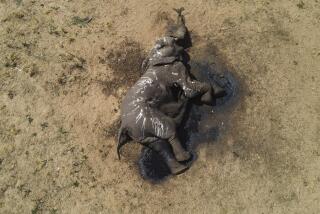Zimbabwe Aims to Save Its Rhinos
- Share via
HARARE, Zimbabwe — Zimbabwe has adopted paradoxical tactics to preserve its herds of rhinoceros and elephants.
To save the rare black rhinos, one unit of rangers has been waging war on poachers, killing 11 who have come into Zimbabwe from neighboring Zambia in the last three years.
But rangers have begun killing elephants in an annual cull of more than 4,000 of the animals to reduce their population.
“One has to draw a contrast between endangered species, which is the rhino, and overpopulated game like the elephant when examining the paradox,” said David Hugh Cumming, the government’s chief ecologist. “Some countries don’t strike a balance between what woodlands can hold against elephant numbers. But when the woodlands go, so do the elephants.”
Ecological Equilibrium
Zimbabwe, in southern Africa, has one of the world’s best records for preservation of wildlife. But a key element in this has been maintenance of ecological equilibrium.
The nation, a bit larger than Montana, boasts the world’s biggest concentration of black rhinos, about 1,500.
But increasingly they have become the prey of poachers, who have come into the Zambezi River Valley, a main rhino habitat, to hunt them for their horns.
A rhino horn, which can fetch as much as $25,000, is prized by Asian herbalists as a medicine and an aphrodisiac and is used in North Yemen for the handles of daggers presented to young men when they come of age.
A 500-member paramilitary unit of the Department of National Parks and Wildlife Management has mounted an exercise called “Operation Stronghold” to curb the rhino poaching.
Other rangers, armed with high-powered hunting rifles, began their annual cull of elephant herds last spring in the Chirisa and Cheziya reserves in western Zimbabwe.
35,000 Elephants
Cumming said that Zimbabwe can support 30,000 to 35,000 elephants without upsetting the balance of nature.
An aerial survey to update the elephant population was under way. But Cumming said that preliminary estimates showed that up to 4,300 elephants will have to be culled nationwide--2,000 from the huge Hwange National Park in the west, 1,000 from the Gonarezhou National Park in the southeast, 800 from the Zambezi Valley and 500 from Chirisa and Cheziya.
For peasant farmers living near the unfenced Chirisa and Cheziya reserves, the arrival of the khaki-uniformed marksmen was an answer to their prayers, said the district council’s senior executive, Raphael Chitsaka.
“Marauding jumbo,” as they are frequently called in the local press, trampled a farmer to death in his cotton field in March and have destroyed some of the first bumper harvest since a devastating drought struck much of Africa in the early 1980s.
Profits From Cull
Chitsaka’s Cheziya Gokwe District Council, a local government body tending to the needs of tens of thousands of villagers, expected to earn about $101,500 from the sale of meat, hides and tusks during the three-month cull.
Other district councils and the peasant families they serve also routinely benefit from the cull.
Some of the meat is given to thousands of refugees who have fled civil war in neighboring Mozambique.
The culling has been going on since 1981, when Zimbabwe’s elephant population was estimated at 50,000, the largest in Africa. Annual culls and some poaching have reduced the population to 40,000 or more. But ecologists point out that this is still more than can be supported on the country’s wildlife reserves, which occupies about 10% of the land.
Since the turn of the century, elephant herds have been crowded into ever-shrinking reserves, while the numbers of humans and domestic livestock have steadily increased, according to Zimbabwe conservationists.
More to Read
Sign up for Essential California
The most important California stories and recommendations in your inbox every morning.
You may occasionally receive promotional content from the Los Angeles Times.










